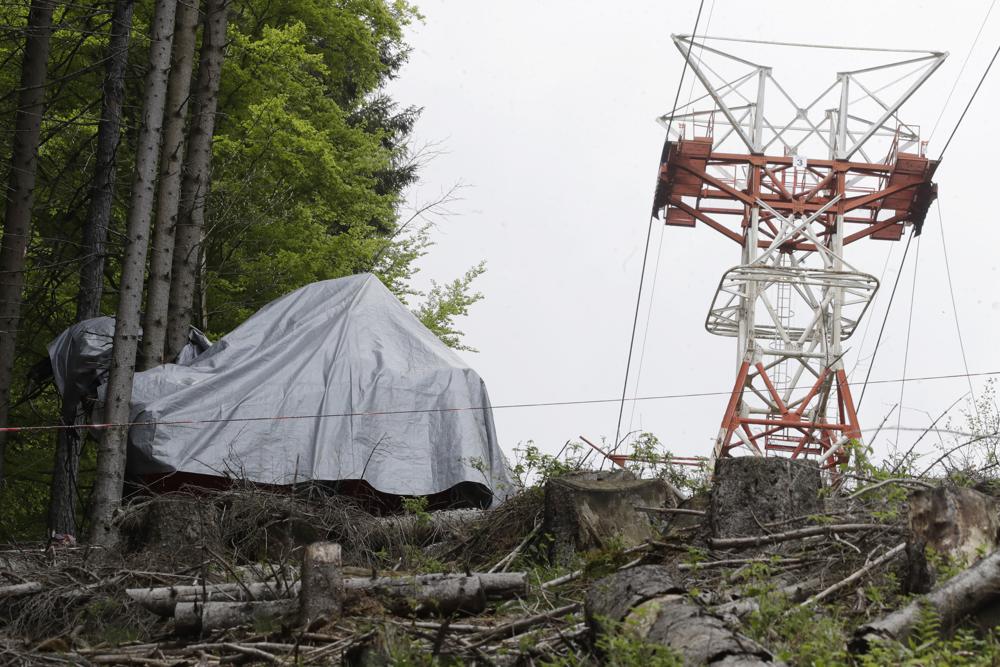The wreckage of a cable car after it collapsed near the summit of the Stresa-Mottarone line in the Piedmont region, northern Italy, Wednesday, May 26, 2021. Police have made three arrests in the cable car disaster that killed 14 people after an investigation showed a clamp, placed on the brake as a patchwork repair effort, prevented the brake from engaging after the lead cable snapped. (AP Photo/Luca Bruno)
ROME (AP) — The three suspects in Italy’s cable car disaster that killed 14 people were allowed to leave prison Sunday after a judge indicated that most of the blame fell on just one of them: a service technician who intentionally disabled the car’s emergency brake because it kept locking spontaneously.
Judge Donatella Banci Buonamici said there wasn’t sufficient evidence suggesting the owner of the Mottarone cable car company, Luigi Nerini, or the maintenance chief, Enrico Perocchio, knew that the technician had deactivated the brake on several occasions even before the May 23 disaster.
After evaluating prosecutors’ request for continued detention of the three, Buonamici ordered the managers freed while allowing the technician, Gabriele Tadini, to leave under house arrest. The three men, who remain under investigation, left Verbania prison early Sunday, accompanied by their lawyers.
Fourteen people were killed when the lead cable of the Mottarone funicular overlooking Lake Maggiore in northern Italy snapped and the emergency brake failed to prevent the cable car from reeling backward down the support line. The cable car pulled off the line entirely when it hit a support pylon, crashed to the ground and then rolled down the mountain until it was stopped by a stand of trees.
The lone survivor, 5-year-old Eitan Biran, remains hospitalized but conscious, with his aunt looking after him. Eitan’s parents, his younger brother and his great-grandparents were killed in the disaster.
It is not known why the pulling cable snapped.
The Italian region of Piedmont observed a minute of silence at noon Sunday, and flags flew at half-staff to mark the moment one week ago when the disaster struck.
Tadini admitted during questioning that he had left a fork-shaped bracket on the cable car’s emergency brake to disable it because it kept locking on its own while the car was in service, said his lawyer, Marcello Perillo.
Speaking to reporters outside Verbania prison, Perillo said Tadini never would have left the bracket in place if he thought doing so might endanger passengers.
“He is not a criminal and would never have let people go up with the braking system blocked had he known that there was even a possibility that the cable would have broken,” Perillo said. “He can’t even begin to get his head around the fact that the cable broke.”
Prosecutors had hypothesized that Tadini’s managers knew about the jerry-rigged brake and had an economic reason in using it to keep the funicular running. Prosecutor Olimpia Bossi said the owner would have had to have taken the whole lift out of service for the more extensive, “radical” repairs that were necessary to fix the faulty emergency brake.
The lift only reopened on April 26 after a lengthy COVID-19 shutdown and was gearing up for the summer tourist season in a picturesque part of northern Italy.
But lawyers for Nerini and Perocchio said the two denied knowing anything about Tadini’s maneuver and said they had no reason to let a cable car without a brake system operate.
Nerini’s attorney, Pasquale Patano, said the owner “had no interest in not repairing the cable car” since he paid a flat fee of 150,000 euros ($183,000) a year for unlimited maintenance from an outside company to keep the funicular safe and operational.
Perocchio similarly denied any knowledge of Tadini’s maneuver, according to his lawyer Andrea Da Prato, who suggested his client had been arrested because the prosecutor felt pressure to produce quick results in the investigation into the tragedy.
As he left the prison, Perocchio said he was “desperately sad” for the victims and never would have authorized disabling the emergency brake.
“I’ve been working in cable cars for 21 years and I know there’s no reason in the world to do that,” he told reporters.
Copyright 2020 Associated Press. All rights reserved.
Source: https://apnews.com/article/europe-italy-36d6a198cf1f553df8c3f1d54e3a03c2









































